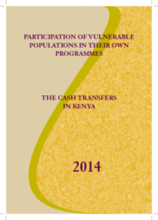Executive Summary
In 2013, the National Gender and Equality Commission conducted an audit of the cash transfer programs for the Orphans and Vulnerable Children (OVC), Persons with Severe Disability (PWSD), and the Elderly in 21 sub-counties of Kenya. The audit was limited to 12 counties; Machakos, Kirinyaga, Marsabit, Nakuru, Vihiga, Siaya, Kajiado, Mombasa, Kilifi, Nyamira, Homabay, and Baringo to provide the national and county governments with a snap shot account of the implementation of the cash transfer program and the level of participation of the vulnerable populations in programs designed for them.
The audit was conducted in two phases due to limited funding during the initial phase. The activity assessed the adherence of the program to the procedures provided for in the regulatory frameworks for cash transfer and several legislative and policy frameworks. The audit also assessed the effects of the program to vulnerable populations and their immediate families, and challenges faced by various players and agencies during the implementation. Based on the outcome of the assessment, the Commission provides actionable recommendations to various state and non-state actors involved in the policy, implementation, and management of the cash transfer programs in Kenya.
The results of the audit show that overall the three cash transfer programs in Kenya have been successful and have had remarkable achievements. Some of the immediate benefits of the program to recipients include improved household food security, retention of children in schools, access to basic health care, formation of social support networks, and increased self-esteem and dignity among beneficiaries. A majority of beneficiaries of the OVC and OP cash transfer programs were females. Men constituted the majority of beneficiaries for the PWSD program. Irrespective of the type of cash transfer program, more than 80% of the beneficiaries reported having dependants to support. Over all, the three cash transfer programs targeted the intended segments of population. However, there were cases where some of the beneficiaries enrolled into the program were not eligible.
The level of participation of the communities and beneficiaries in the administration of the cash transfer program is generally low. The audit identified key challenges hindering their participation and included: lack of correct and adequate information on the processes of enrollment into the program, delay and unpredictable transfer of the funds, and unforeseen fiscal and social costs among others. In addition, the audit identified main difficulties faced by the administrators of the program; inadequate trainings, budgets, and geographical coverage.
This report provides the following recommendations:
- The national and the county governments should review targeting, coordination and implementation guidelines of the cash transfer program in light of the principles of devolution and recent legislation frameworks such as the Social Assistance Act of 2013 for a sustainable social security program at national and county level.
- There is need for review of the budget allocated to cash transfer programs, type of cash transfer programs in Kenya, coverage of the intervention, and ultimately the amount of funds transferred directly to beneficiaries.
- There is opportunity for better coordination of the CTP with other forms of social assistance such as provision of assistive devices for PWD or nutritional programs for infants and pregnant mothers.
- The national and county government should enforce the measures to reduce irregularities such as enrolment of ineligible populations into the program
- During the transition period to devolved government, the national and county governments should put in place structures and mechanism to ensure smooth continuation of cash transfer services at all levels
- The implementing agencies should roll out an intensive public education program to sensitize communities, administrators and all other stakeholders of the cash transfer program about the objects, value and process of implementation of the program.
- The implementing agencies should make use of ICT to increase efficiency of the program including automation of registration process and transfer of funds. There is need to tap into the high penetration of mobile telephones in Kenya.
- The program should have a systematic monitoring framework and mechanism including audits undertaken by independent bodies such as NGEC and accountability initiatives from the communities.
- There is need to develop a participatory framework for community engagement in the design, implementation, audit and evaluation of the intervention and such should be employed on routine basis.

